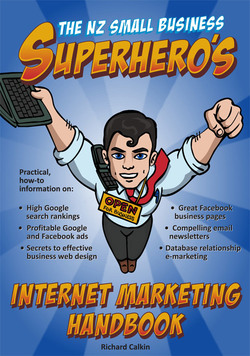Your calls to action can be divided into two main categories:
- Your join pitch; and
- Your sales/lead calls to action
Read the following excerpt from my book ‘The NZ Small Business Superhero’s Marketing Handbook’ to find out how to use these types of calls to action to persuade your visitors…
1. Your join pitch
One of your calls to action – your join pitch – has the specific purpose of joining the visitor up to your contact database.
They may not be ready to purchase right away, but if you can keep in touch with them over a period of time, when they are ready to buy they will make contact.
While no money changes hands, there is still an exchange of value in a join pitch transaction. Your visitor is exchanging their contact information for something they perceive to be of value. Therefore if you expect to be successful in growing your email list, your join pitch must be enticing. Simply having a field called “email address” and a subscribe button is not going to result in many sign-ups.
Good examples of enticing join pitches include appealing descriptions of the e-newsletter content they can expect to receive, a free report download, filling in a brief quiz and getting an instant result in the form of some customised content, or the promise of exclusive, valuable information in the future.
2. Your sales/lead call to action
If a website features online sales, then the buy or add to cart button represents the ultimate call to action. However, the primary goal of most small business websites is to generate an enquiry, which can then be followed up by someone from the business.
You need to make it as easy and enticing as possible for your visitor to make an enquiry when they are ready. Having your phone number in the header is a good idea, as is a “call back” form on the right hand side of every page. Your main enquiry call to action
Testing various time-limited, special offers for web enquiries is also a good idea. For example, a free add-on or a discount for all enquiries before a certain date.
The promise of a quick response to an online enquiry works well to increase the response rate. In other words, your visitor has a problem they want solved as soon as possible, so if you can promise to solve it for them quickly, they will be more likely to respond.
To read more, you can purchase my book ‘The NZ Small Business Superhero’s Internet Marketing Handbook’ by clicking here.

